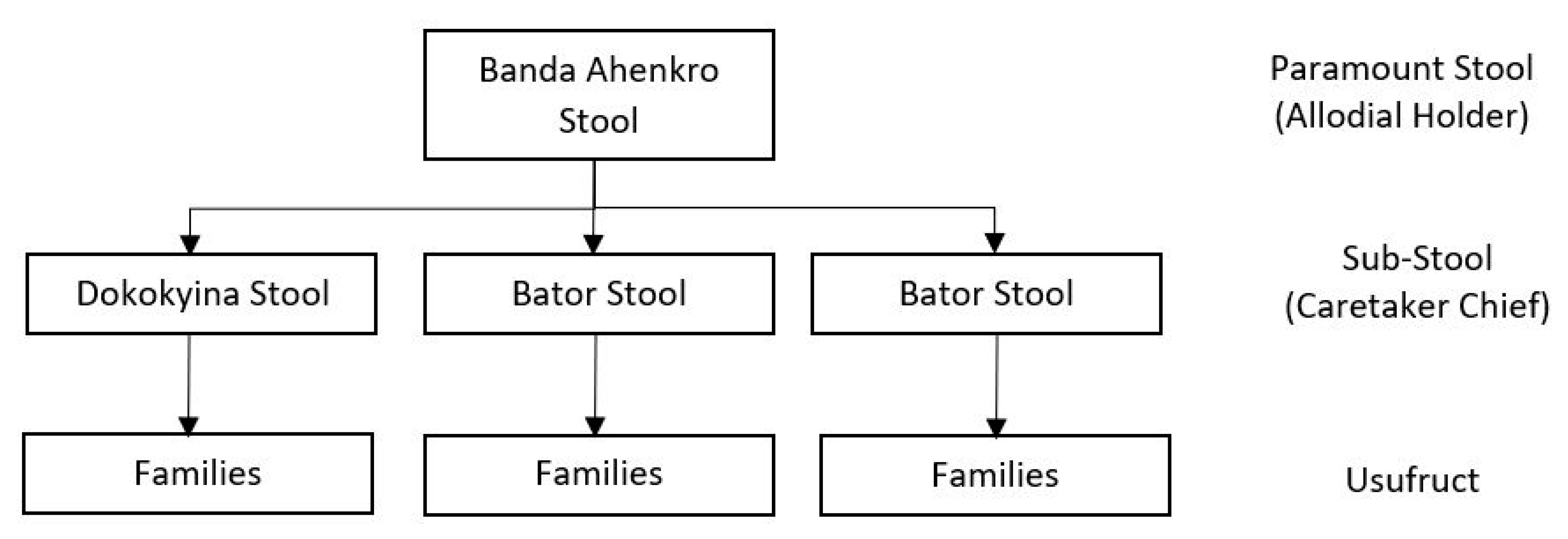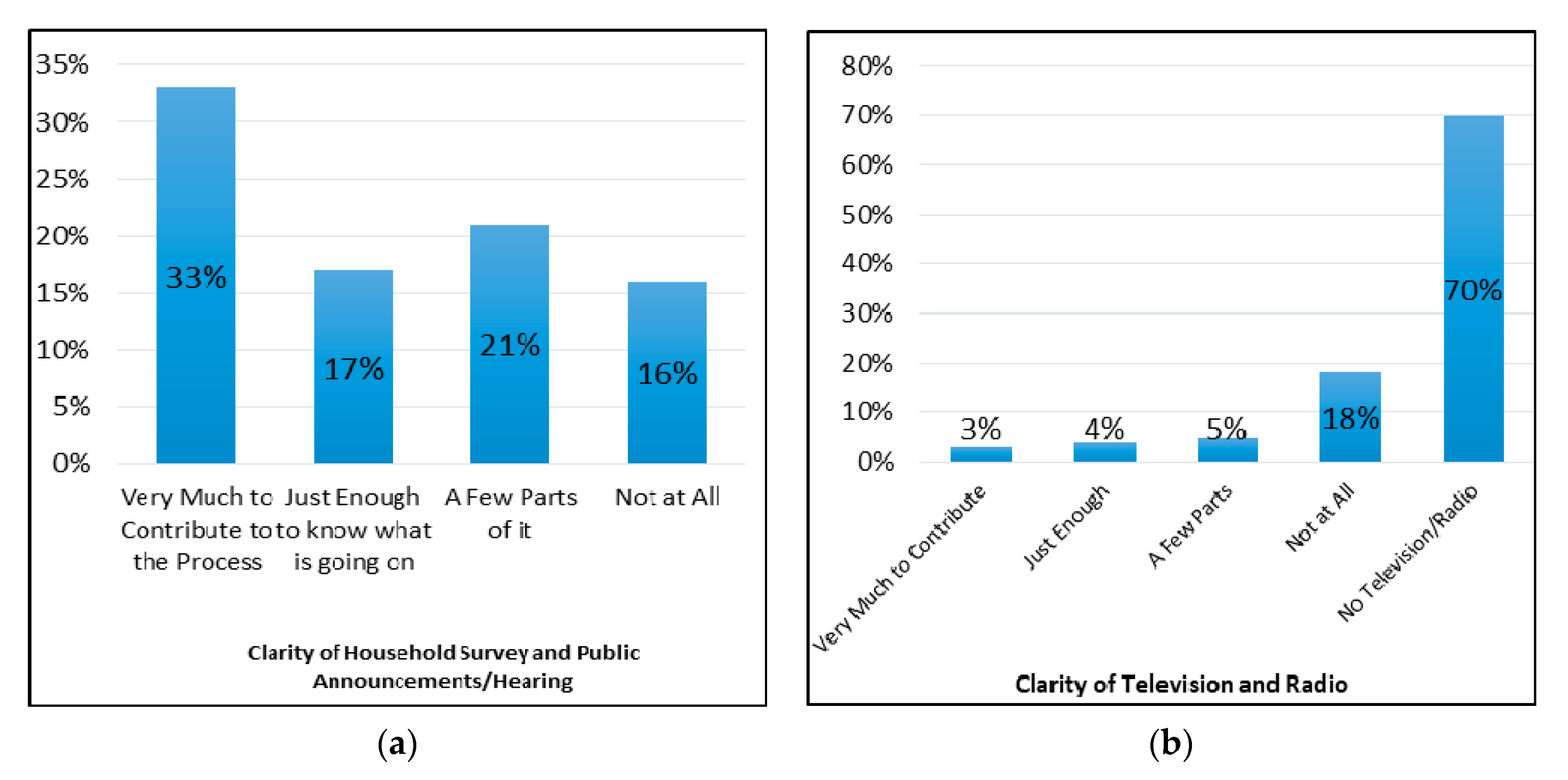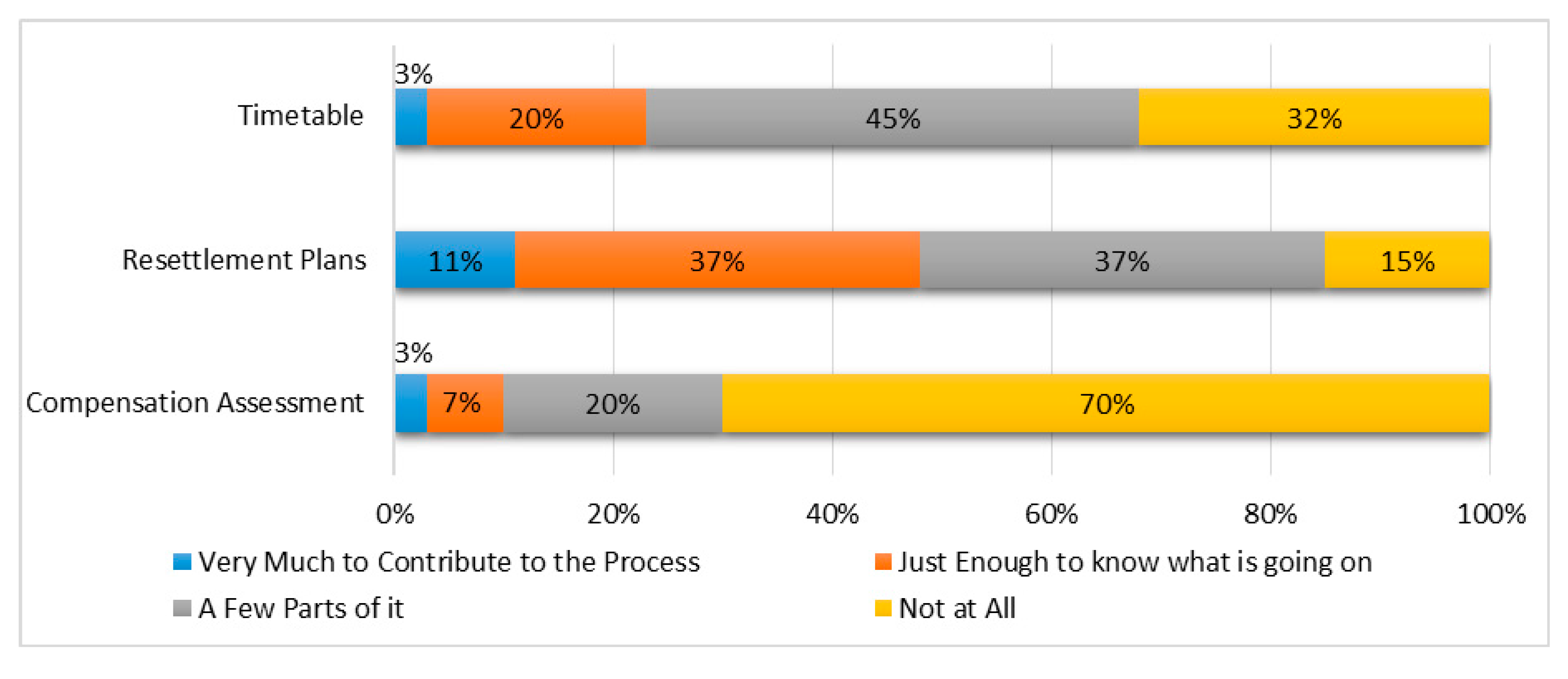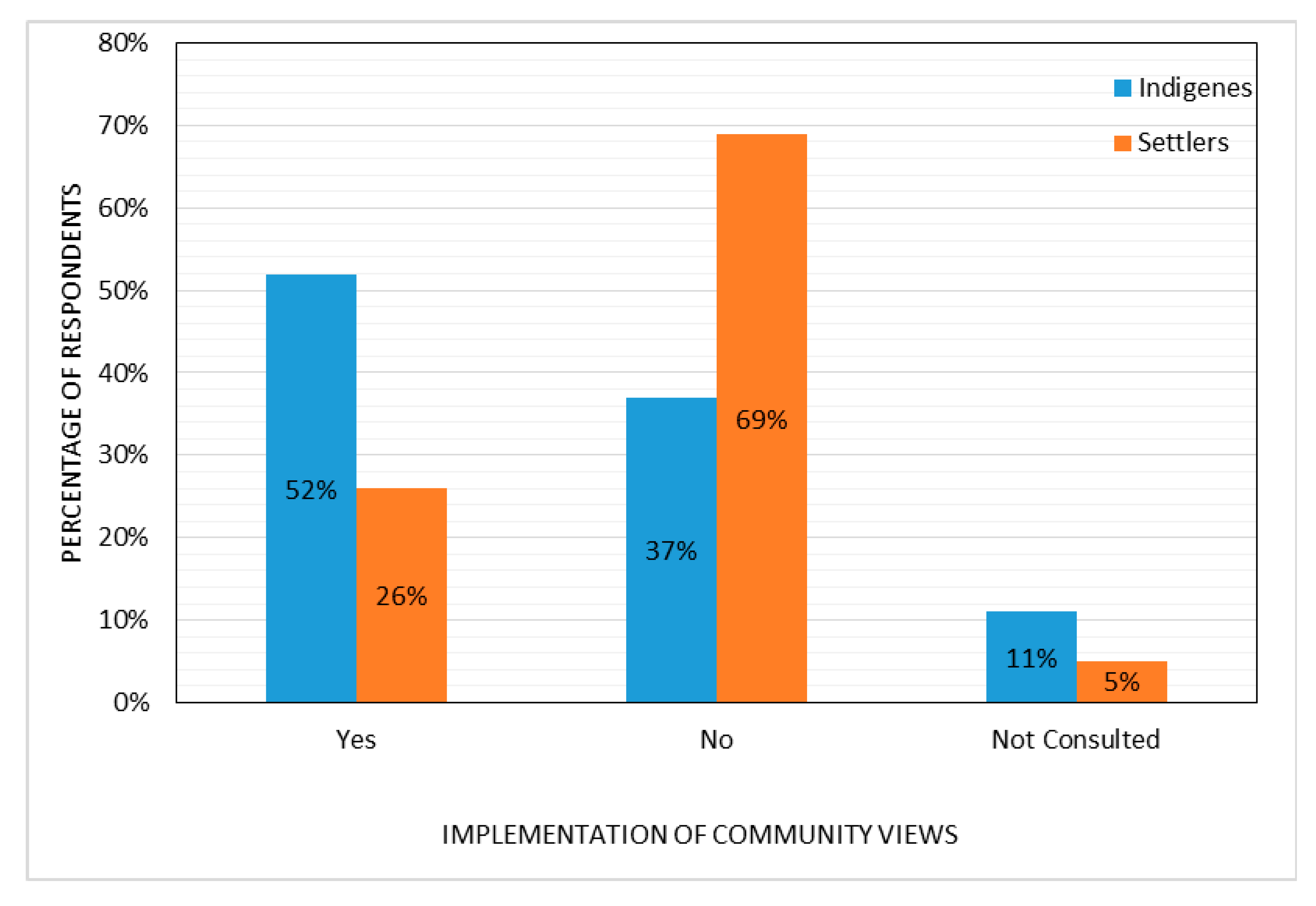In the Land of the Dammed: Assessing Governance in Resettlement of Ghana’s Bui Dam Project
Abstract
:1. Introduction
2. Governance, Customary Lands and Resettlement from Compulsory Land Acquisition: The Nexus
2.1. Governance and Good Governance Principles
2.2. Customary Lands
2.3. Resettlement from Compulsory Land Acquisition
2.4. Monitoring Resettlement from Compulsory Land Acquisition: A Good Governance: Assessment Framework
2.4.1. Transparency
2.4.2. Public Participation and Inclusiveness
2.4.3. Equity and Rule of Law
2.4.4. Accountability
2.4.5. The Assessment Framework
3. Study Area
4. Research Design and Methodology
- N = population size (124 for this study)
- p = the estimated frequency for the sample size n; that is proportion of success (50% in this study)
- E = tolerable error (15% in this study)
- Zα/2 = value given for the confidence interval according to the precision desired (1.96 for this study).
5. Good Governance in the Implementation of the Bui Hydroelectric Dam Resettlement
5.1. High Transparency in Resettlement, Low Transparency in Compulsory Land Acquisition
5.1.1. Access to Information
5.1.2. Openness of the Process
5.2. Low Public Participation
5.2.1. Involvement of Actors
5.2.2. The Decision-Making Process
5.3. Inequity and Low Level of Rule of Law
5.3.1. Inadequate Compensation and Tenure Security
5.3.2. Lost Livelihoods, Unequal Treatment of Affected Persons and Low Rule of Law
5.4. Low Level of Accountability
5.4.1. Assignment of Responsibilities
5.4.2. Accountability Arrangements
6. Discussion
6.1. Transparency: Access to Information and Openness of the Process
6.2. Public Participation and Inclusiveness
6.3. Equity and Rule of Law: Compensation, Livelihood Revival and Treatment of Affected Persons
6.4. Accountability
7. Conclusions
Supplementary Materials
Author Contributions
Conflicts of Interest
Appendix A
| Principle | Thematic Area | Indicator | Score |
|---|---|---|---|
| Transparency | Access to Information |
| Y |
| Y | ||
| N | ||
| Y | ||
| Openness of Process |
| Y | |
| N | ||
| N | ||
| N | ||
| Y | ||
| N | ||
| Public Participation and Inclusiveness | Involvement of Actors |
| Y |
| N | ||
| N | ||
| Decision-making Process |
| Y | |
| N | ||
| N | ||
| N | ||
| N | ||
| Equity and Rule of Law | Fair and Adequate Compensation And Tenure Security |
| N |
| N | ||
| N | ||
| N | ||
| N | ||
| N | ||
| Y | ||
| Y | ||
| Livelihood and Equal Treatment of Parties, and Rule of Law |
| N | |
| N | ||
| N | ||
| Y | ||
| Accountability | Assignment of Responsibilities |
| Y |
| Y | ||
| Y | ||
| Accountability Arrangement |
| N | |
| N | ||
| N | ||
| N |
References
- Cernea, M.M. Compensation and benefit sharing: Why resettlement policies and practices must be reformed. Water Sci. Eng. 2008, 1, 89–120. [Google Scholar] [CrossRef]
- Arnall, A.; Thomas, D.S.G.; Twyman, C.; Liverman, D. Flooding, Resettlement, and Change in Livelihoods: Evidence from Lural Mozambique. Disasters 2013, 37, 468–488. [Google Scholar] [CrossRef] [PubMed]
- De Wet, C. The Experience with Dams and Resettlement in Africa. World Comm. Dams 2000, 1, 171–183. [Google Scholar]
- Okuku, E.O.; Bouillon, S.; Ochiewo, J.O.; Munyi, F.; Kiteresi, L.I.; Tole, M. The impacts of hydropower development on rural livelihood sustenance. Int. J. Water Resour. Dev. 2016, 32, 267–285. [Google Scholar] [CrossRef] [Green Version]
- Bartolome, L.J.; de Wet, C.; Mander, H.; Nagraj, V.K. Displacement, Resettlement, Rehabilitation, Reparation, and Development; WCD Thematic Review; Secretariat of the World Commission on Dams: Cape Town, South Africa, 2000. [Google Scholar]
- Syagga, P.M.; Olima, W.H.A. The Impact of Compulsory Land Acquisition on Displaced Households. Habitat Int. 1996, 20, 61–75. [Google Scholar] [CrossRef]
- Larbi, W.O.; Antwi, A.; Olomolaiye, P. Compulsory Land Acquisition in Ghana—Policy and Praxis. Land Use Policy 2004, 21, 115–127. [Google Scholar] [CrossRef]
- Hensengerth, O. Interaction of Chinese Institutions with Host Governments in Dam Construction: The Bui Dam in Ghana. In Evolution of Dam Policies; Scheumann, W., Hensengerth, O., Eds.; Springer: Berlin/Heidelberg, Germany; New York, NY, USA, 2014; pp. 229–271. [Google Scholar]
- Raschid-Sally, L.; Akoto-Danso, E.K.; Kalitsi, E.A.K.; Ofori, B.D.; Koranteng, R.T. The Resettlement Experience of Ghana Analyzed via Case Studies of the Akosombo and Kpong Dams. In Proceedings of the 9th Annual Symposium on Poverty Research, Colombo, Sri Lanka, 2 December 2008. [Google Scholar]
- Owusu, K.; Obour, P.B.; Nkansah, M.A. Downstream effects of dams on livelihoods of river-dependent communities: The case of Ghana’s Kpong Dam. Geografisk Tidsskrift J. Geogr. 2017, 117, 1–10. [Google Scholar] [CrossRef]
- Urban, F.; Nordensvard, J.; Siciliano, G.; Li, B. Chinese Overseas Hydropower Dams and Social Sustainability: The Bui Dam in Ghana and the Kamchay Dam in Cambodia. Asia Pac. Policy Stud. 2015, 2, 573–589. [Google Scholar] [CrossRef]
- Owen, J.R.; Deanna, K. Mining-induced displacement and resettlement: A critical appraisal. J. Clean. Prod. 2015, 87, 478–488. [Google Scholar] [CrossRef]
- Yankson, P.W.K.; Asiedu, A.B.; Owusu, K.; Urban, F.; Siciliano, G. The Livelihood Challenges of Resettled Communities of the Bui Dam Project in Ghana and the Role of Chinese Dam-builders. Dev. Policy Rev. 2017. [Google Scholar] [CrossRef]
- Naab, F.Z.; Nunbogu, A.M.; Dinye, R.D.; Dongzagla, A. Resettlement and Livelihood Sustainability in Sub-Saharan Africa: The Case of Bui Hydro-Power Dam Project, Ghana. World Acad. Sci. Eng. Technol. Int. J. Soc. Behav. Educ. Econ. Bus. Ind. Eng. 2016, 10, 1780–1788. [Google Scholar]
- Obour, P.B.; Owusu, K.; Agyeman, E.A.; Ahenkan, A.; Madrid, À.N. The impacts of dams on local livelihoods: A study of the Bui Hydroelectric Project in Ghana. Int. J. Water Resour. Dev. 2016, 32, 286–300. [Google Scholar] [CrossRef]
- Atindana, S.A.; Mensah, P.; Alhassan, E.H.; Ampofo-Yeboah, A.; Abobi, S.M.; Akongyuure, D.N.; Abarike, E.D. The Socio—Economic Impact of Bui Dam on Resettled Communities; A Case Study of Lucene and Agbegikuro Communities in the Northern Region of Ghana. UDS Int. J. Dev. 2015, 2, 45–51. [Google Scholar]
- Mettle, M. Forced Resettlement in Ghana; Norwegian University of Science and Technology: Trondheim, Norway, 2011. [Google Scholar]
- Otu-Tei, C. Broken Promises: Ghana’s Bui Dam Resettlement; World Rivers Review: Berkeley, CA, USA, March 2014. [Google Scholar]
- Asiama, K.O. Governance in Resettlement from Compulsory Land Acquisition and Resettlement: A Case Study of the Bui Dam Project. Master’s Thesis, University of Twente, Enschede, The Netherlands, 2015. [Google Scholar]
- UNDP. Governance for Sustainable Human Development; United Nations Development Programme: New York, NY, USA, 1997.
- Food and Agriculture Organisation (FAO). Good Governance in Land Tenure and Administration. FAO Land Tenure Studies 9; Food and Agriculture Organisation: Rome, Italy, 2007. [Google Scholar]
- World Bank. Strengthening World Bank Group Engagement on Governance and Anticorruption; Joint Ministerial Committee of the Boards of Governers of the World Bank and the Fund on the Transfer of Real Resources to Developing Countries: Washington, DC, USA, 2007. [Google Scholar]
- Bell, K.C. Good Governance in Land Administration; Responding to Global Agenda—FIG Working Paper; FIG: Helsinki, Finland, 2007. [Google Scholar]
- Zakout, W.; Wehrmann, B.; Torhonen, M.-P. Good Governance in Land Administration; World Bank: Washington, DC, USA, 2006. [Google Scholar]
- Parigi, V.; Geeta, P.; Kailasam, R. Ushering in Transparency for Good Governance; Centre for Good Governance: Hyderabad, India, 2004.
- Abubakari, Z.; van der Molen, P.; Bennett, R.; Kuusaana, E.D. Land consolidation, customary lands, and Ghana’s Northern Savannah Ecological Zone: An evaluation of the possibilities and pitfalls. Land Use Policy 2016, 54, 386–398. [Google Scholar] [CrossRef]
- Arko-Adjei, A. Adapting Land Administration to the Institutional Framework of Customary Tenure. Ph.D. Thesis, Delft University of Technology, Delft, The Netherlands, 2011. [Google Scholar]
- Asiama, S.O. Current Changes in Customary/Traditional Land Delivery Systems in Sub-Saharan African Cities—Ghana. In Housing the Poor through African Neo-Customary Land Delivery Systems; Mattingly, M., Durand-Lasserve, A., Eds.; DFID: London, UK, 2004; pp. 41–57. [Google Scholar]
- Hardin, G. The Tragedy of the Commons. Science 1968, 162, 1243–1248. [Google Scholar] [CrossRef] [PubMed]
- Van Gils, H.; Siegl, G.; Bennett, R. The living commons of West Tyrol, Austria: Lessons for land policy and land administration. Land Use Policy 2014, 38, 16–25. [Google Scholar] [CrossRef]
- Asiama, K.O.; Bennett, R.; Zevenbergen, J. Land Consolidation for Sub-Saharan Africa’s Customary Lands—The Need for Responsible Approaches. Am. J. Rural Dev. 2017, 5, 39–45. [Google Scholar]
- Adu-Gyamfi, A. An Overview of Compulsory Land Acquisition in Ghana: Examining Its Applicability and Effects. Environ. Manag. Sustain. Dev. 2012, 1, 187–203. [Google Scholar] [CrossRef]
- Kasanga, K.R.; Kotey, N.A. Land Management in Ghana: Building on Tradition and Modernity; International Institute for Environment and Development: London, UK, 2001. [Google Scholar]
- Ollennu, N.A. Principles of Customary Land Law in Ghana; Sweet and Maxwell: London, UK, 1962. [Google Scholar]
- Asiama, K.O.; Bennett, R.M.; Zevenbergen, J.A. Participatory Land Administration on Customary Lands: A Practical VGI Experiment in Nanton, Ghana. ISPRS Int. J. Geo-Inf. 2017, 6, 186. [Google Scholar] [CrossRef]
- Asiama, S.O. Crossing the Barrier of Time. The Asante Woman in Urban Land Development. Africa Rivista Trimestrale di Studi e Documentazione dell’Istituto Italiano per l’Africa e l’Oriente 1997, 52, 212–236. [Google Scholar]
- Asiama, K.O.; Bennett, R.M.; Zevenbergen, J.A. Land consolidation on Ghana’s rural customary lands: Drawing from The Dutch, Lithuanian and Rwandan experiences. J. Rural Stud. 2017, 56, 87–99. [Google Scholar] [CrossRef]
- Boni, S. Indigenous Blood and Foreign Labor: The Ancestralization of Land Rights in Sefwi (Ghana). In Land and the Politics of Belonging in West Africa; Kuba, R., Lentz, C., Eds.; Brill Academic Pub: Boston, MA, USA, 2006; pp. 161–186. [Google Scholar]
- Berry, S. Ancestral Property: Land, Politics and ‘the Deeds of the Ancestors’ in Ghana and Côte d’Ivoire. In Contesting Land and Custom in Ghana; Ubink, J.M., Amanor, K.S., Eds.; Leiden University Press: Leiden, The Netherlands, 2008; pp. 27–54. [Google Scholar]
- Anim-Odame, W.K. Compulsory Acquisition and Compensation in Ghana: Principles and Practice. In American Real Estate Society Conference; American Real Estate Society: Seattle, WA, USA, 2011. [Google Scholar]
- Parliament of Ghana. Constitution of Ghana; Ghana Publishing Company: Accra, Ghana, 1992. [Google Scholar]
- Van Eerd, M.; Banerjee, B. Evictions, Acquisition, Expropriation and Compensation: Practices and Selected Case Studies; Global Land Tool Network: Nairobi, Kenya, 2013. [Google Scholar]
- Cernea, M.M. Involuntary Resettlement in Development Projects; The World Bank: Washington, DC, USA, 1988. [Google Scholar]
- The World Bank. Involuntary Resettlement Sourcebook—Planning and Implementation in Development Projects; The World Bank: Washington, DC, USA, 2004. [Google Scholar]
- Asian Development Bank. Handbook on Resettlement: A Guide to Good Practice; Asian Development Bank: Manila, Philippines, 1998. [Google Scholar]
- Alias, A.; Daud, N.M. Payment of Adequate Compensation for Land Acquisition in Malaysia. Pac. Rim Prop. Res. J. 2006, 12, 326–349. [Google Scholar] [CrossRef]
- Shapiro, E.; Mackmin, D.; Sams, G. Modern Methods of Valuation; Taylor and Francis: Hoboken, NJ, USA, 2012. [Google Scholar]
- Schmidt-Soltau, K.; Brockington, D. Protected Areas and Resettlement: What Scope for Voluntary Relocation? World Dev. 2007, 35, 2182–2202. [Google Scholar] [CrossRef]
- German, L.; Schoneveld, G.; Mwangi, E. Processes of Large-Scale Land Acquisition by Investors: Case Studies from Sub-Saharan Africa; Center for International Forestry Research (CIFOR): Bogor, Indonesia, 2011. [Google Scholar]
- WCD. Dams and Development—A Framework for Decision-Making; Earthscan Publications Ltd.: London, UK; Sterling, VA, USA, 2000. [Google Scholar]
- Van der Molen, P.; Tuladhar, A.M. Corruption and Land Administraton. In Proceedings of the Shaping the Change, XXIII FIG Congress, Munich, Germany, 8–13 October 2006. [Google Scholar]
- Deininger, K.; Selod, H.; Burns, A. The Land Governance Assessment Framework: Identifying and Monitoring Good Practice in the Land Sector; The World Bank: Washington, DC, USA, 2012. [Google Scholar]
- Birkinshaw, P. Transparency as a Human Right. In Transparency: The Key to Better Governance? Hood, C., Heald, D., Eds.; Oxford University Press: Oxford, UK, 2006; pp. 47–58. [Google Scholar]
- Mostert, E. The Challenge of Public Participation. Water Policy 2003, 5, 179–197. [Google Scholar]
- Ty, P.; van Westen, A.C.M.; Zoomers, A. Compensation and Resettlement Policies after Compulsory Land Acquisition for Hydropower Development in Vietnam: Policy and Practice. Land 2013, 2, 678–704. [Google Scholar] [CrossRef]
- United Nations. United Nations Declaration on the Rights of Indigenous Peoples; United Nations: New York, NY, USA, 2008. [Google Scholar]
- United Nations Human Rights. Free, Prior and Informed Consent of Indigenous Peoples; United Nations Human Rights: Geneva, Switzerland, 2013. [Google Scholar]
- Singer, J.; Pham, H.T.; Hoang, H. Broadening stakeholder participation to improve outcomes for dam-forced resettlement in Vietnam. Water Resour. Rural Dev. 2014, 4, 85–103. [Google Scholar] [CrossRef]
- Curry, N. Rights of Access to Land for Outdoor Recreation in New Zealand: Dilemmas Concerning Justice and Equity. J. Rural Stud. 2001, 17, 409–419. [Google Scholar] [CrossRef]
- Magadza, C.H.D. Social Impacts of the Creation of Lake Kariba. In Involuntary Resettlement in Africa; Cook, C.C., Ed.; World Bank: Washington, DC, USA, 1994. [Google Scholar]
- Chambers, R. The Volta River Experience; Pall Mall Press Ltd.: London, UK, 1970. [Google Scholar]
- Dicey, A. Introduction to the Study of the Law of the Constitution; Macmillan: London, UK, 1897. [Google Scholar]
- Licht, A.N.; Goldschmidt, C.; Schwartz, S.H. Culture rules: The Foundations of the Rule of Law and other Norms of Governance. J. Comp. Econ. 2007, 35, 659–688. [Google Scholar] [CrossRef]
- FAO. Compulsory Acquisition of Land and Compensation. FAO Land Tenure Studies 10; Food and Agriculture Organisation: Rome, Italy, 2009. [Google Scholar]
- Viitanen, K.; Falkenbach, H.; Nuuja, K. Compulsory Purchase and Compensation: Recommendations for Good Practice; International Federation of Surveyors: Copenhagen, Denmark; FIG: Helsinki, Finland, 2010. [Google Scholar]
- Graham, J.; Amos, B.; Plumptre, T. Governance Principles for Protected Areas in the 21st Century; Institute on Governance: Ottawa, ON, Canada, 2003. [Google Scholar]
- Yin, R.K. Case Study Research: Design and Methods; Sage Publications: Thousand Oaks, CA, USA, 2003. [Google Scholar]
- ERM (Environmental Resources Management). Resettlement Policy Framework; Environmental Resources Management: London, UK, 2007. [Google Scholar]
- Ghana Statistical Service (GSS). Digest of Macroeconomic Data; Ghana Statistical Service (GSS): Accra, Ghana, 2011.
- UN-Habitat. Tools to Support Transparency in Land Administration; UN-Habitat: Nairobi, Kenya, 2013. [Google Scholar]
- UN-Habitat. Count Me in: Surveying for Tenure Security and Urban Land Management; UN-Habitat: Nairobi, Kenya, 2010. [Google Scholar]
- Ubink, J.M.; Quan, J.F. How to combine tradition and modernity? Regulating customary land management in Ghana. Land Use Policy 2008, 25, 198–213. [Google Scholar] [CrossRef]
- Juul, K.; Lund, C. Negotiating Property in Africa; Heinemann: Portsmouth, UK, 2002. [Google Scholar]
- McEwan, C. ‘Bringing Government to the People’: Women, Local Governance and Community Participation in South Africa. Geoforum 2003, 34, 469–481. [Google Scholar] [CrossRef]
- Smith, B. Public Policy and Public Participation Engaging Citizens and Community in the Development of Public Policy; Health Canada: Ottawa, ON, Canada, 2003. [Google Scholar]
- Parliament of Ghana. Minerals and Mining (Compensation and Resettlement) Regulations (L.I. 2175); Parliament of Ghana: Accra, Ghana, 2012.
- Parliament of Ghana. State Lands Act, 1962 (Act 125); Parliament of Ghana: Accra, Ghana, 1962. [Google Scholar]
- Kusiluka, M.M.; Kongela, S.; Kusiluka, M.A.; Karimuribo, E.D.; Kusiluka, L.J.M. The Negative Impact of Land Acquisition on Indigenous Communities’ Livelihood and Environment in Tanzania. Habitat Int. 2011, 35, 66–73. [Google Scholar] [CrossRef]
- Gyapong, P. Assessing Customary Land Tenure Institutions for Land Administration in Ghana: Good Governance Perspective. Master’s. Thesis, University of Twente, Enschede, The Netherlands, 2009. [Google Scholar]
- Newell, P.; Wheeler, J. Rights, Resources and the Politics of Accountability; Zed Books: London, UK, 2006. [Google Scholar]
- Schedler, A. Conceptualizing Accountability. In The Self-Restraining State: Power and Accountability in New Democracies; Schedler, A., Diamond, L., Plattner, M., Eds.; Lynne Rienner: London, UK, 1999; pp. 13–28. [Google Scholar]
| 1 | This includes the government, large private interests and the institutions. |
| 2 | This includes the citizens, the civil society and their institutions. |
| 3 | Interview with the Resettlement Officer. |
| 4 | Interview with the Resettlement Officer. |
| 5 | Focus group discussion with Unit Committee Members. |
| 6 | Interview with the Resettlement Officer. |





| Principle | Thematic Area | Indicator |
|---|---|---|
| Transparency | Access to Information |
|
| Openness of Process |
| |
| Public Participation and Inclusiveness | Involvement of Actors |
|
| Decision-making Process |
| |
| Equity and Rule of Law | Fair and Adequate Compensation and Tenure Security |
|
| Livelihood and Equal Treatment of Parties and Rule of Law |
| |
| Accountability | Assignment of Responsibilities |
|
| Accountability Arrangement |
|
| Demographic Criteria | Number of Respondents | Percentage of Respondents | |
|---|---|---|---|
| Ethnicity | Indigene (Banda and Mo) | 19 | 50% |
| Settler (Ewe) | 19 | 50% | |
| Gender | Male | 23 | 60 |
| Female | 15 | 40 | |
| Educational Level | Cannot Read, or Understand English | 23 | 60% |
| Can Understand and Read English | 1 | 3% | |
| Primary | 3 | 8% | |
| Junior Secondary | 8 | 21% | |
| Senior Secondary/Technical/Vocational | 1 | 3% | |
| Tertiary | 2 | 5% | |
| Prior Primary Occupation | ||||||
|---|---|---|---|---|---|---|
| Civil Service | Business | Crop Farming | Fishing | Retired | Unemployed | |
| Indigenes | 3 | 3 | 18 | 1 | 1 | 1 |
| % of Indigenes | 16% | 16% | 95% | 5% | 5% | 5% |
| Settlers | 4 | 8 | 12 | 7 | 0 | 0 |
| % of Settlers | 21% | 42% | 63% | 37% | 0% | 0% |
| Total | 7 | 11 | 30 | 8 | 1 | 1 |
| % of Sample (n) | 18% | 29% | 79% | 21% | 3% | 3% |
| Current Primary Occupation | ||||||
|---|---|---|---|---|---|---|
| Civil Service | Business | Crop Farming | Fishing | Retired | Unemployed | |
| Indigenes | 3 | 3 | 17 | 0 | 2 | 1 |
| % of Indigenes | 16% | 16% | 90% | 0% | 11% | 5% |
| Settlers | 4 | 4 | 11 | 1 | 0 | 4 |
| % of Settlers | 21% | 21% | 58% | 5% | 0% | 21% |
| Total | 7 | 7 | 28 | 1 | 2 | 5 |
| % of Sample (n) | 18% | 18% | 74% | 3% | 5% | 13% |
© 2017 by the authors. Licensee MDPI, Basel, Switzerland. This article is an open access article distributed under the terms and conditions of the Creative Commons Attribution (CC BY) license (http://creativecommons.org/licenses/by/4.0/).
Share and Cite
Asiama, K.; Lengoiboni, M.; Van der Molen, P. In the Land of the Dammed: Assessing Governance in Resettlement of Ghana’s Bui Dam Project. Land 2017, 6, 80. https://doi.org/10.3390/land6040080
Asiama K, Lengoiboni M, Van der Molen P. In the Land of the Dammed: Assessing Governance in Resettlement of Ghana’s Bui Dam Project. Land. 2017; 6(4):80. https://doi.org/10.3390/land6040080
Chicago/Turabian StyleAsiama, Kwabena, Monica Lengoiboni, and Paul Van der Molen. 2017. "In the Land of the Dammed: Assessing Governance in Resettlement of Ghana’s Bui Dam Project" Land 6, no. 4: 80. https://doi.org/10.3390/land6040080






